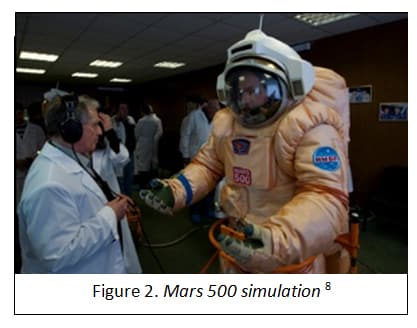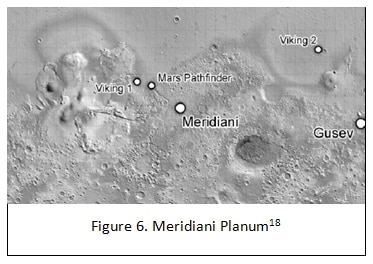Introduction
About 110 years ago, when McKinley was President of United States, the concept “Man on Moon” was an insignificant consideration to society and to the government’s budget. In present day, space constitutes a large portion of the 2011 government budget plan. President Barack Obama is predicting a manned Mars mission to orbit the planet by mid 2030s followed by a safe return to Earth and eventually a human expedition on the surface of the red planet1. On Apollo 17 was the eleventh manned lunar space mission in the NASA Apollo program and the last manned mission to the Moon2. December 7, 1972, Commander Eugene Cernan was the last man to have walked on the Moon.
Robotic Probe Success
Nations around the world have created human Mars mission propositions to not only visit the planet but to eventually establish a colony similar to Earth. Conducting a human expedition to Mars can pose quite a challenge globally. Many countries have the available technology and innovation required to relativize this plan but is short the budget and scientific research1. Since the 1960s, approximately 30 probes have been sent towards mars, but unfortunately less than 1/3 have survived the trip3. This does not give nations encouragement to replace these probes with humans. Space exploration programs have had success with landing robotic packages on Mars but the inability to retrieve them, if NASA is unable to accomplish this goal, then how are they supposed to return humans.
Russia and U.S Preparedness
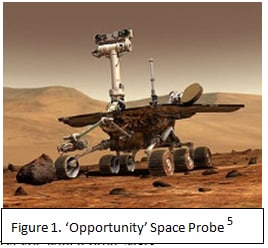 Russia and the United States currently hold the spotlight with regard to space exploration1. NASA, the United States space exploration program, has come a long way since Neil Armstrong’s first step on Moon, and has placed great ingenuity on exploring space and beyond. On June 10 and June 17 2003, NASA launched space probes, ‘Spirit’ and ‘Opportunity’ (Fig.1) in search for signs of water history4. These probes are able to capture rich information and transmit it back to Earth via Mars Odyssey and Mars Global Surveyor which orbit Mars daily4.
Russia and the United States currently hold the spotlight with regard to space exploration1. NASA, the United States space exploration program, has come a long way since Neil Armstrong’s first step on Moon, and has placed great ingenuity on exploring space and beyond. On June 10 and June 17 2003, NASA launched space probes, ‘Spirit’ and ‘Opportunity’ (Fig.1) in search for signs of water history4. These probes are able to capture rich information and transmit it back to Earth via Mars Odyssey and Mars Global Surveyor which orbit Mars daily4.
Another one of NASAs space exploration initiatives was the Constellation Program, which was a human spaceflight program designed to operate away from Earths environment6.This program failed because it lacked innovation and was over budget, however, the Orion spacecraft which was developed primarily for the Constellation program is still being considered for future exploration6. As for Russia’s preparedness, their Institute of Biomedical Problems have conducted a unique space project called Mars5007. Mars500 (Fig.2) is a six crew 520-day simulation of a manned Mars expedition intended to investigate some of the physical and psychological effects that humans might encounter on a long-duration trip to Mars7. The Russian Mars500 simulation provides society with optimism and confidence that ultimately, one day, man will step foot on Mars.
Statement of Aim
A human exploration to Mars, and an eventual settlement, would likely be considered an extraordinary breakthrough in the human race. The aim of this report is to discuss the challenges’ that countries will endure for developing a mission to Mars, the scientific resources required to make this concept reality and the expedition preparations.
Transportation
‘Getting there’ is the most critical component of an expedition to Mars. A design is one thing, but the time frame of when to launch the heavy lift rocket is another. Every 26 months, an optimum energy window arises, which is when the planets are closest together9. At this point less energy is used and rocket fuel is conserved9. This window informs astronauts of the appropriate time to ‘take-off’. The further the launch from the energy window, the more energy required to escape Earth’s gravitational pull9.
Design
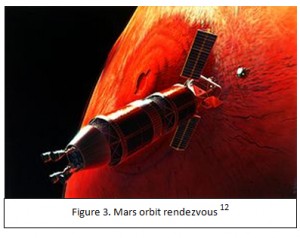 At present, “Heavy lift rockets” are being considered as the most effective and efficient approach for Mars expedition. These rockets have the ability to send crew capsules, propulsion systems and large quantities of supplies into deep space10.It is crucial that these rockets be designed with knowledge that a Mars manned mission is remotely distinct from a lunar mission. Astronauts are committed on this journey for years and with that in mind, vast amounts of supplies are needed11. Insufficient fuel for a return trip is posing quite a challenge for scientific researchers. Solutions to this problem have surfaced, such as the Mars Orbit Rendezvous (MOR) and the Earth Return Vehicle (ERV). The MOR (Fig. 3) allows less unnecessary weight to be sent to Mars surface, such as fuel for return trip12. It also permits astronauts to perform surface-to-ship trips for the purpose of conducting strong data communication between Earth and Mars, since the time delay on Mars is 20 minutes12. However, traveling back and forth can be quite dangerous due to the radiation caused by Mars atmosphere12.
At present, “Heavy lift rockets” are being considered as the most effective and efficient approach for Mars expedition. These rockets have the ability to send crew capsules, propulsion systems and large quantities of supplies into deep space10.It is crucial that these rockets be designed with knowledge that a Mars manned mission is remotely distinct from a lunar mission. Astronauts are committed on this journey for years and with that in mind, vast amounts of supplies are needed11. Insufficient fuel for a return trip is posing quite a challenge for scientific researchers. Solutions to this problem have surfaced, such as the Mars Orbit Rendezvous (MOR) and the Earth Return Vehicle (ERV). The MOR (Fig. 3) allows less unnecessary weight to be sent to Mars surface, such as fuel for return trip12. It also permits astronauts to perform surface-to-ship trips for the purpose of conducting strong data communication between Earth and Mars, since the time delay on Mars is 20 minutes12. However, traveling back and forth can be quite dangerous due to the radiation caused by Mars atmosphere12.
The Martian atmosphere consists of 95% carbon dioxide13. The ERV is shipped to Mars prior to astronaut’s arrival. This vehicle travels around Mars surface and combines the hydrogen gas, which was brought from Earth, with Mars atmosphere13. This chemical mixture produces methane, a powerful fuel needed for the crews return to Earth13.
Hazards
 Scientists are still in the midst of conducting research on the negative effects of radiation from space on the human body. The greatest threat to human space exploration is cosmic rays (Fig. 4) or “GCRs” and high energy particles from the sun14. GCRs breakdown DNA molecules and destroy cells by absorbing the skin of the spacecraft and the people aboard14.
Scientists are still in the midst of conducting research on the negative effects of radiation from space on the human body. The greatest threat to human space exploration is cosmic rays (Fig. 4) or “GCRs” and high energy particles from the sun14. GCRs breakdown DNA molecules and destroy cells by absorbing the skin of the spacecraft and the people aboard14.
When considering the design of the spacecraft, researchers suggest that it be built of mostly aluminum because its light and strong material will absorb about half of the generated radiation1.
“Storm Shelters” are located on the spacecraft to shield humans from radiation15. Developers suggest surrounding the living quarters with hydrogen fuel and water tanks which can assist with the absorption of radiation15. Other challenges that the crew might face are lack of social community, inaccessibility of adequate medical facilities, crowded conditions for long duration and low gravity/low light environment1.
Restrictions
A crew of four is the optimum number of passengers required for this journey15.The Mars Direct proposal for a manned mission to Mars was created in 1990 by NASA engineers Robert Zubrin and David Baker which contained the designs for the “Mars Habitat Unit” consisting of a living and working environment for four crew members16. With fewer passengers, supplies will be lighter, and more medical resources, oxygen, food and water can be provided. Living conditions on the spaceship and Mars habitat will be less confined.
Research Station/Habitat
The Polar Regions (Fig.5) are an exceptional location choice for surface station. The Polar Ice sheets are not the safest location to 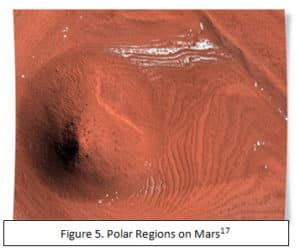 land a spacecraft but they do offer plenty resources, energy and most importantly, research. If landing safety was the most crucial aspect for a Mars mission, than the Meridiani Planum would be the best choice for location. The Meridiani Planum (Fig.6) is known for its smooth surface and mineral deposits, but Mars exploration rover, ‘Opportunity’ (Viking 1), as yet to discover liquid, ice water in this region that may be used for fuel18.
land a spacecraft but they do offer plenty resources, energy and most importantly, research. If landing safety was the most crucial aspect for a Mars mission, than the Meridiani Planum would be the best choice for location. The Meridiani Planum (Fig.6) is known for its smooth surface and mineral deposits, but Mars exploration rover, ‘Opportunity’ (Viking 1), as yet to discover liquid, ice water in this region that may be used for fuel18.
Polar Regions provide astronauts with easy access to large quantities of frozen water and Carbon Dioxide19. CO2 is used to create rocket fuel for the return trip and for local mobility19. During the spring-summer seasons, the sun constantly shines above the horizon; this would initially be the best time to conduct research because of the constant power and energy available by the sun19. The layers of the polar ice sheets can determine the history of liquid water existing on Mars surface, one of NASAs scientific goals19. Another possible reason to habituate on the polar ice sheets is to conduct research based on the search for life, another one of NASAs goals. Organic molecules typically lie within Mars atmosphere except for in the poles where they are found along the surface preserved by a low temperature “deep freeze” 19.
Living Quarters
The Mars Habitat Unit (Fig.6), adapted by NASA, is composed of four personal sleeping quarters, exercise room, hygienic facilities (water purification system), medical facility and laboratory areas for conducting scientific research20. The habitat will also include a small rover designed for surface exploration. An airlock will exist at the entrance of the Habitat. When entering the airlock, the low-pressurized Martian air is replaced by the habitats higher pressure air; the reverse occurs when crew members leave20. A medical facility is an essential component of the Mars Habitat Unit. Emergencies can occur at any instance and crew need to be prepared. The facility should contain surgical kits, gasses (oxygen, nitrous oxcide), pharmaceutical drugs, heart monitor and ultrasound, and peripheral equipment20. A communications facility with an advanced technology system will be available for transmitting data collected from Mars to Earth (20 minute time delay)20. Solar arrays will be ineffective due to dust storms, so a need for nuclear power sources to sustain a functional living and working environment is required16. As for local resources, water can be found under Mars surface or within the atmosphere. As well, Mars atmosphere is composed of 95% Carbon dioxide, which can be used to produce methane, for fuel, and air13.
Sociological Challenges
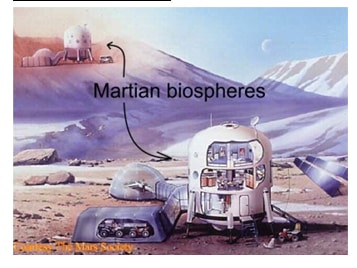 There can be quite a heated argument between countries and individuals when discussing whether or not a human exploration of Mars will be beneficial towards society. Conducting this mission involves billions of dollars in investment from the government. With this in mind, government will have to cut back on other expenses, such as education or health care. Some citizens of the United States will argue that society should be focusing on present issues and not the future. By cutting the health care budget, people will have to incur higher taxes and pay a larger sum for visiting the doctor. People are ill on Earth but the government is investing money on life on another planet. Before the government decides to invest vast amounts of money into space exploration, it should ask society what is best for them, even though, space exploration is a something that should concern the government.
There can be quite a heated argument between countries and individuals when discussing whether or not a human exploration of Mars will be beneficial towards society. Conducting this mission involves billions of dollars in investment from the government. With this in mind, government will have to cut back on other expenses, such as education or health care. Some citizens of the United States will argue that society should be focusing on present issues and not the future. By cutting the health care budget, people will have to incur higher taxes and pay a larger sum for visiting the doctor. People are ill on Earth but the government is investing money on life on another planet. Before the government decides to invest vast amounts of money into space exploration, it should ask society what is best for them, even though, space exploration is a something that should concern the government.
Mission Justification
The greatest challenge to developing a human expedition to Mars is finding the 150 billion dollars needed to develop the program. The technology and innovation is available but money to support the development is not. Corporate sponsorships along with tax-money can assist in funding for this global program and if successful, can produce approximately 30-90 billion dollars22. The problem is that companies are focusing on providing services for their current customers on Earth and are hesitant about contributing their budget towards a program that has the possibility of failure22.
The United States are currently the top investors in space innovation and development23. If the United States is victorious in achieving a manned mission to Mars, it has the advantage of receiving enormous financial and technological gains that are crucial to solving their debt issue. However, if the world, were successful in this mission, the returns would be shared among all participated countries, therefore, decreasing United States chance at redeeming their debt. Unfortunately, the United States has not yet demonstrated that they are competent to send humans to Mars independently. Such a mission would likely require global collaboration, as the costs, time, energy, and man-power required to run the trip are likely too high a burden for any one country to take on23.
NASA’s four scientific goals include determining whether or not life was present on Mars, the characterization of Martian climate and geology and preparation for future human exploration24. As for the rest of the world, the national goal of landing a man on Mars would trigger a new era in humanity.
Preparations
The repercussions of such a trip can be massive if the appropriate preparations are not conducted initially. Preparations need to fit with data collected from Mars rovers, such as choosing a suitable landing site that is safe and nearest to the current research projects. Also, the amount of food, fuel and water needed for an approximate 600 day excursion needs to be assessed. Most importantly, scientists need to consider whether the crew members are physically and psychologically ready to take part in a mission that can isolate them from society for at least three years. The added risk of atmospheric radiation on the human body also needs to be accounted for.
Conclusions
We have been to the Moon, a vast amount of times, and safely back, Mars probes have yet to dissever new breakthrough discoveries and the International Space Station remains a stable success; it is time society takes the next big step into space and beyond. The unknown still remains out there, waiting for exploration. A manned mission to Mars would ignite so many new ground-breaking results that can change mankind as we know it. By 2030’s, let us hope, that man will venture to Mars and science will be revolutionized forever.
References
1. Manned mission to Mars- http://en.wikipedia.org/wiki/Manned_mission_to_Mars
2. Apollo Space Program- http://en.wikipedia.org/wiki/Apollo_program
3. Mars Exploration Rovers- http://science.howstuffworks.com/mars-rover1.htm
4. NASA space robotic probes- http://i-heart-robots.blogspot.co/2006/03/nasa-space-robotic-probes.html
5. Mars Exploration Rovers; ‘Opportunity’ and ‘Spirit’- http://en.wikipedia.org/wiki/Mars_Exploration_Rover
6. Constellation Program- http://en.wikipedia.org/wiki/Constellation_program
7. Mars 500 simulation- http://www.bbc.co.uk/news/science-environment-12337108
8. Mars 500 astronaut- http://www.astrobio.net/exclusive/3445/mars-mockup-in-moscow
9. Optimum launch window- http://athena.cornell.edu/mars_facts/sb_launch_window.html
10. Heavy Lift Rockets- http://www.nasa.gov/news/media/trans/obama_ksc_trans.html
11. How humans would get to Mars- http://www.foxnews.com/story/0,2933,534394,00.html
12. Mars Orbit Rendezvous- http://en.wikipedia.org/wiki/Mars_orbit_rendezvous
13. Fueling a human mission to Mars- http://library.thinkquest.org/11147/fuel.htm
14. Radiation from Earth to Mars- http://science.nasa.gov/science-news/science-at-nasa/2004/17feb_radiation/
15. Safety preparations regarding radiation in space – http://www.marsdaily.com/reports/Preparations_Continue_For_Manned_Expedition_To_Mars_One_Day_999.html
16. Mars habitat unit- http://en.wikipedia.org/wiki/Mars_Direct#Mars_Habitat_Unit
17. Picture of Mars Polar Regions –http://fireballs-meteorites.blogspot.com/2008/10/october-2008.html
18. Meridiani Planum- http://www.mars.tv/mer/sites.html
19. Polar Regions- http://www.geoffreylandis.com/pole.html
20. Mars Living Conditions- http://www.exploremarsnow.org/
21. Mars habitat unit illustration- http://csa.gc.ca/eng/educators/resources/mars/grade4_food.asp
22. Corporate Sponsorship- http://www.foxnews.com/scitech/2011/01/17/advertising-pay-mission-mars-scientist-says/
23. Global Collaberation- http://www.universetoday.com/75263/could-a-human-mars-mission-be-funded-commercially/
24. Scientific Goals- http://marsrover.nasa.gov/science/goals.html

